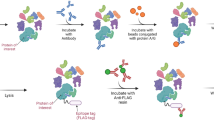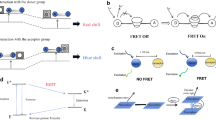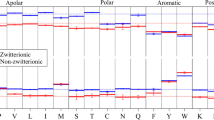Abstract
Isomers of aspartyl (Asp) residues have been found in various proteins in aged human tissues. Isomerization of Asp is considered as one of the potential factors to facilitate amyloidosis via the oligomerization of amyloid beta (Aβ) peptides. It is still challenging to analyze such isomerization in real time, and no information has been provided about Asp isomerization in situ. In this work, we report a real-time quantitation of the isomerization at Asp in Aβ fragment peptides, Aβ2−9 (A2EFRHD7SG9) and Aβ2−16 (A2EFRHD7SGYEVHHQK16) by using solution-state 1H NMR in situ. The simultaneous NMR detection of isomerization product and reactant enables us to compare how fast Asp is converted to isoAsp in terms of the kinetics of isomerization in real time. In Aβ2−9, the rate constant, k of the increase of isoAsp7 was almost parallel with the decrease of Asp7; the rate constants were estimated to be (1.3 ± 0.1) × 10−3 h−1 for Asp7 decrease and (1.2 ± 0.1) × 10−3 h−1 for the increase of isoAsp7 at 70 °C. In Aβ2−16, however, k of isoAsp7 increase was much less than the Asp7 decrease. This is due to an inhibitory effect of histidine (His) on the progress of Asp isomerization; the coupling of His imidazole ring with a succinimide (Suc) intermediate makes Suc lifetime longer enough to interfere with the conversion to isoAsp.






Similar content being viewed by others
References
Fisher, G.H., D’Aniello, A., Vetere, A., Cusano, G.P., Chavez, M., Petrucelli, L.: Quantification of D-aspartate in normal and Alzheimer brains. Neurosci. Lett. 143, 215–218 (1992)
Roher, A.E., Lowenson, J.D., Clarke, S., Wolkow, C., Wang, R., Cotter, R.J., Reardon, I.M., Zürcher-Neely, H.A., Heinrikson, R.L., Ball, M.J.: Structural alterations in the peptide backbone of beta-amyloid core protein may account for its deposition and stability in Alzheimer’s disease. J. Biol. Chem. 268, 3072–3083 (1993)
Masters, P.M., Bada, J.L., Zigler Jr., J.S.: Aspartic acid racemization in heavy molecular weight crystallins and water insoluble protein from normal human lenses and cataracts. Proc. Natl. Acad. Sci. USA 75, 1204–1208 (1978)
Fujii, N., Satoh, K., Harada, K., Ishibashi, Y.: Simultaneous stereoinversion and isomerization at specific aspartic acid residues in alpha A-crystallin from aged human lens. J. Biochem. 116, 663–669 (1994)
Fujii, N., Ishibashi, Y., Satoh, K., Fujino, M., Harada, K.: Simultaneous racemization and isomerization at specific aspartic acid residues in alpha B-crystallin from the aged human lens. Biochim. Biophys. Acta 1204, 157–163 (1994)
Fujii, N., Kawaguchi, T., Sasaki, H., Fujii, N.: Simultaneous stereoinversion and isomerization at the Asp-4 residue in betaB2-crystallin from the aged human eye lenses. Biochemistry 50, 8628–8635 (2011)
Takata, T., Murakami, K., Toyama, A., Fujii, N.: Identification of isomeric aspartate residues in βB2-crystallin from aged human lens. Biochim. Biophys. Acta 1866, 767–774 (2018)
Kaji, Y., Oshika, T., Takazawa, Y., Fukayama, M., Takata, T., Fujii, N.: Localization of D-beta-aspartic acid-containing proteins in human eyes. Investig. Ophthalmol. Vis. Sci. 48, 3923–3927 (2007)
Kaji, Y., Oshika, T., Okamoto, F., Fujii, N.: Immunohistochemical localization of D-beta-aspartic acid in pingueculae. Br. J. Ophthalmol. 93, 974–976 (2009)
Kaji, Y., Oshika, T., Takazawa, Y., Fukayama, M., Fujii, N.: Immunohisto-chemical localisation of D-beta-aspartic acid-containing proteins in climatic droplet keratopathy. Br. J. Ophthalmol. 93, 977–979 (2009)
Helfman, P.M., Bada, J.L.: Aspartic acid racemisation in dentine as a measure of ageing. Nature 262, 279–281 (1976)
Powell, J.T., Vine, N., Crossman, M.: On the accumulation of D-aspartate inelastin and other proteins of the ageing aorta. Atherosclerosis 97, 201–208 (1992)
Ohtani, S., Yamamoto, T., Matsushima, Y., Kobayashi, Y.: Changes in the amount of D-aspartic acid in the human femur with age. Growth Dev. Aging 62, 141–148 (1998)
Cloos, P.A., Fledelius, C.: Collagen fragments in urine derived from bone resorption are highly racemized and isomerized: a biological clock of protein aging with clinical potential. Biochem. J. 3, 473–480 (2000)
Ritz-Timme, S., Laumeier, I., Collins, M.: Age estimation based on aspartic acid racemization in elastin from the yellow ligaments. Int. J. Legal Med. 117, 96–101 (2003)
Fujii, N., Tajima, S., Tanaka, N., Fujimoto, N., Takata, T., Tadashi, S.: The presence of D-beta-aspartic acid-containing peptides in elastic fibers of sun-damaged skin: a potent marker for ultraviolet-induced skin aging. Biochem. Biophys. Res. Commun. 294, 1047–1051 (2002)
Mori, Y., Aki, K., Kuge, K., Tajima, S., Yamanaka, N., Nagai, R., Yoshii, H., Fujii, N., Watanabe, M., Kinouchi, T., Fujii, N.: UV B-irradiation enhances the racemization and isomerizaiton of aspartyl residues and production of Nepsilon-Carboxymethyl Lysine (CML) in keratin of skin. J. Chromatogr. B 879, 3303–3309 (2011)
Ha, S., Kim, I., Takata, T., Kinouchi, T., Isoyama, M., Suzuki, M., Fujii, N.: Identification of -amino acid-containing peptides in human serum. PLoS ONE 12(12), e0189972 (2017)
Geiger, T., Clarke, S.: Deamidation, isomerization, and racemization at asparaginyl and aspartyl residues in peptides. succinimide-linked reactions that contribute to protein degradation. J. Biol. Chem. 262, 785–794 (1987)
Magami, K., Kim, I., Fujii, N.: A single Asp isomer substitution in an αA-crystallin-derived peptide induces a large change in peptide properties. Exp. Eye Res. 192, 107930 (2020)
Sakaue, H., Kinouchi, T., Fujii, N., Takata, T., Fujii, N.: Isomeric replacement of a single aspartic acid induces a marked change in protein function: the example of Ribonuclease A. ACS Omega 2, 260–267 (2017)
Kozin, S.A., Cheglakov, I.B., Ovsepyan, A.A., Telegin, G.B., Tsvetkov, P.O., Lisitsa, A.V., Makarov, A.A.: Peripherally applied synthetic peptide isoAsp7-Aβ(1–42) triggers cerebral β-amyloidosis. Neurotox. Res. 24, 370–376 (2013)
Aki, K., Okamura, E.: D-β-aspartyl residue exhibiting uncommon high resistance to spontaneous peptide bond cleavage. Sci. Rep. 6, 21594 (2016)
Capasso, S.: Thermodynamic parameters of the reversible isomerization of aspartic residues via a succinimide derivative. Thermochim. Acta 286, 41–50 (1996)
Fujii, N., Aki, K., Fujii, N.: D-amino-acid-containing proteins in living body. In: Pályi, G., Zucchi, C., Caglioti, L. (eds.) The Soai Reaction and Related Topic, Accademia Nazionale di Scienze Lettere e Arti Modena, Italy (2012), Chap. 2, pp. 35–52
Brennan, T.V., Clarke, S.: Effect of adjacent histidine and cysteine residues on the spontaneous degradation of Asparaginyl- and aspartyl-containing peptides. Int. J. Pept. Protein Res. 45, 547–553 (1995)
Sang-aroon, W., Ruangpornvisuti, V.: Theoretical study on isomerization and peptide bond cleavage at aspartic residue. J. Mol. Model. 19, 3627–3636 (2013)
Catak, S., Monard, G., Aviyente, V., Ruiz-Lo´pez, M.F.: Computational study on nonenzymatic peptide bond cleavage at asparagine and aspartic acid. J. Phys. Chem. A 112, 8752–8761 (2008)
Aki, K., Okamura, E.: Kinetics of the competitive reactions of isomerization and peptide bond cleavage at l-α- and d-β-aspartyl residues in an αA-crystallin fragment. J. Pept. Sci. 23, 28–37 (2017)
Aki, K., Fujii, N., Fujii, N.: Kinetics of isomerization and inversion of aspartate 58 of αA-crystallin peptide mimics under physiological conditions. PLoS ONE 8(3), e58515 (2013)
Hooi, M.Y., Raftery, M.J., Truscott, R.J.: Interconversion of the peptide isoforms of aspartate: stability of isoaspartates. Mech Ageing Dev. 134(3–4), 103–109 (2013)
Sadakane, Y., Fujii, N., Nakagomi, K.: Determination of rate constants for β-linkage isomerization of three specific aspartyl residues in recombinant human αA-crystallin protein by reversed-phase HPLC. J. Chromatogr. B 879(29), 3240–3246 (2011)
Platzer, G., Okon, M., McIntosh, L.P.: pH-dependent random coil 1H, 13C, and 15N chemical shifts of the ionizable amino acids: a guide for protein pKa measurements. J. Biomol. NMR 60, 109–129 (2014)
Grassi, L., Regl, C., Wildner, S., Gadermaier, G., Huber, C.G., Cabrele, C., Schubert, M.: Complete NMR assignment of succinimide and its detection and quantification in peptides and intact proteins. Anal. Chem. 89, 11962–11970 (2017)
Okamura, E., Nakahara, M.: NMR study directly determining drug delivery sites in phospholipid bilayer membranes. J. Phys. Chem. B 103, 3505–3509 (1999)
Okamura, E., Nakahara, M.: NMR studies on lipid bilayer interfaces coupled with anesthetics and endocrine disruptors. In: Volkov A.G. (ed.) Liquid Interfaces in Chemical, Biological, and Pharmaceutical Applications, Marcel Dekker, New York (2001) Chap. 32, pp. 775–805
Acknowledgements
This work was partly supported by Grants-in-Aid for Scientific Research from Japan Society for the Promotion of Science (15K04501 and 19K05394) and by Hyogo Science and Technology Association (No. 25073). The authors thank Kento Inoue for sample preparation and NMR data analysis.
Author information
Authors and Affiliations
Corresponding author
Additional information
Publisher's Note
Springer Nature remains neutral with regard to jurisdictional claims in published maps and institutional affiliations.
Rights and permissions
About this article
Cite this article
Aki, K., Okamura, E. Isomerization of Aspartyl Residue in Amyloid Beta Fragments: The Kinetics by Real-Time 1H NMR Under Neutral and Basic Conditions. J Solution Chem 49, 1293–1303 (2020). https://doi.org/10.1007/s10953-020-01018-7
Received:
Accepted:
Published:
Issue Date:
DOI: https://doi.org/10.1007/s10953-020-01018-7




